
Home About Us Contact Us India Tourism
Welcome to www.pinkcity2india.com
Pinkcity Excursions
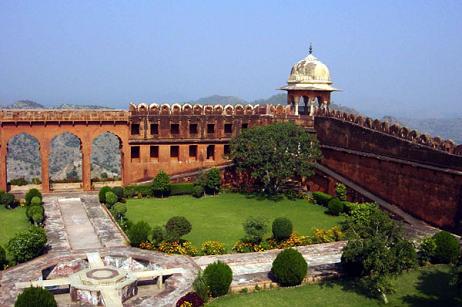
|
Jaipur is one of the most alluring cities of Rajasthan, India. Every year, people from all over the world come to explore the majestic city of Jaipur. There are numerous tourist attractions in Jaipur; still the city offers many other places in the suburbs to satisfy the appetite of tourists. You can visit Abhaneri, a small town, popular for its astonishing step wells and Harshad Mata Temple. On the other hand, Sanganer is famous for manufacturing the quality hand-made paper in India. Rajasthan is famous for its traditions and culture. Keeping the traditions, Bagru is a small village, where you can see the traditional block-printing without any modern adulterations in its process. For adventurous people, Ranthambore National Park and Sariska National Park would be the best options to surf. Sambhar Lake is another destination where you can observe the salt-making process. Continuing the excursion list, Samode is alluring with its Heritage Palace. Art lovers would definitely love the Persian and Arabian manuscripts at Tonk. Bairath with its remnants of medieval Indian architecture attracts the tourists from far and near. Ramgarh Lake is a huge artificial lake, the other attractions being the hunting lodge and polo grounds in Ramgarh. All these beautiful destinations offer swift excursion from Jaipur. Abhaneri Abhaneri is a small town village, situated at a distance of 95 km from Jaipur, on Jaipur-Agra road. The place is popular for the amazing 'Baoris' (step wells) and Harshat Mata Temple. The village of Abhaneri is believed to be established by the King Raja Chand. Bairath Bairath is a place of historical significance, located at a distance of 86 kms from Jaipur, on Shahpura-Alwar Road. Bairath is said to have existed from the times of Mahabharata. In that period, Bairath was known as Virata Nagar. It used to be the capital of Abhimanyu's (Arjuna's son) father-in-law. Karauli Karauli is a small village, situated at a distance of 182 km from Jaipur. Founded in 1348, Karauli is well-known for its Madan Mohanji Temple. The temple is dedicated to Lord Krishna. Initially, the town was known as Kalyanpuri, which was named after the local deity Kalyanji. 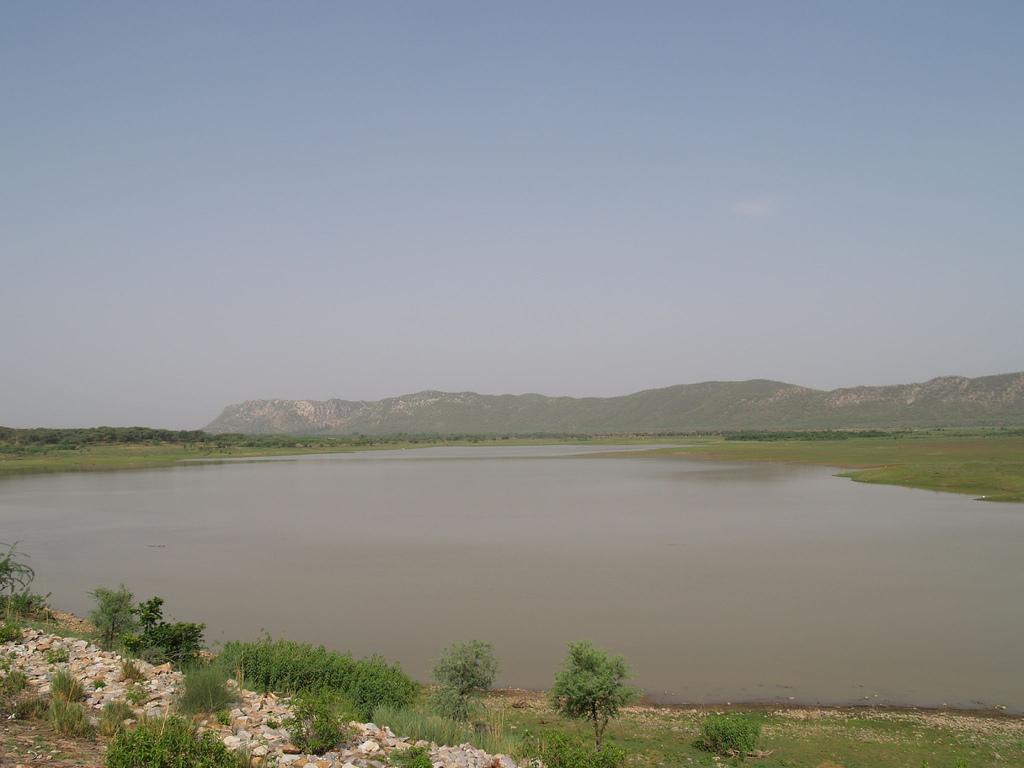
Ramgarh Ramgarh is located at a distance of 25kms from the city of Jaipur. In the present day, this primeval spot is eminent for its huge artificial lake. This lake has been shaped by raising a high bund amidst the hills covered with trees. Ranthambore National Park Ranthambore National Park is located in the eastern part of Rajasthan at a comfortable distance of 130kms from Jaipur. Nestled between the Aravali and Vindhya mountain ranges, Ranthambore National Park used to be the hunting ground of Maharajas of Jaipur. The Park is an eye treat for the lovers of wild-life. Various natural rivers and man-made lakes flow through the National Park of Ranthambore. Sariska National Park Sariska National Park is a wildlife sanctuary, located at a distance of 107 km from Jaipur. The Park possesses historic monuments and temples, which depicts the legacy of the Maharajas of Alwar. The Park is bigger than Ranthambore but has a similar topography. Tonk Tonk is a small town, located at a distance of 96 kms from Jaipur. This little town of Tonk is also known as the "Lucknow of Rajasthan" due to its elegance. Tonk is popular among tourists for its magnificent mosques, mansions and havelis. No doubt Jaipur is one of the most popular destinations in Rajasthan but there are a number of other wonderful destinations around Jaipur that one can head to on excursions from Jaipur. Jaipur Hub provides complete information on a number of excursion destinations around Jaipur. These beautiful destinations offer quick getaways from the Pink City. Tonk is an old town, situated about 100 kilometres from Jaipur that offers an ideal getaway from Jaipur. Tonk is home to some of the beautiful monuments that include the Golden Mansion, which has an exquisite mirror work. Gaitor is another quick getaway from Jaipur, which is about 15 kilometres from Jaipur. Gaitor is known for its beautiful cenotaph of Maharaja Sawai Jai Singh II. The place also has a number of other beautiful monuments. Those inclined towards art and crafts can take an excursion to Sanganer, which is known for its textile block printing, blue pottery and papermaking. Samode is another beautiful destination 40 kilometres from Jaipur. Samode is a beautiful village that has a few heritage monuments. Other places that tourists can visit from Jaipur include Agra, Ramgarh, Abhaneri, Balaji, Ajmer, Pushkar, Alwar and Karauli. Jaipur Hub offers a number of tour packages and hotel booking facility for tourists who are planning to visit Jaipur and other tourist destinations in and around Jaipur. To book a tour to Jaipur or more information on tour packages to Jaipur, all you need to do is just fill up the form given below and we will get back to you. Excursions from Jaipur o Jodhpur o Udaipur o Ajmer o Samode o Pushkar o Alwar o Agra o Tonk And Gaitor o Ranthambore o Kishangarh and Roopangarh o Mandawa o Sariska Here are a number of excursions around Jaipur, Rajasthan. Some of the famous Jaipur excursions are mentioned below: Sanganer Located 16 km from Jaipur, Sanganer is famous for its beautiful Jain temples. The most famous temple is the Shri Digambar Jain temple. This temple has a stone shrine with three pinnacles. There is an idol of Parshwanath with 7 serpent hoods in the center. However, the main idol of Adinathji is enshrined in the temple behind this. Sanganer is also famous for its crafts and hand-printed textiles. 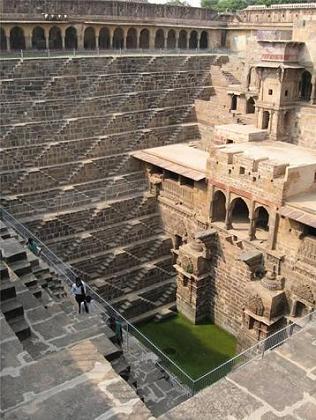
Abhaneri Approximately 95 km from Jaipur, on the Jaipur-Agra road, is the village of Abhaneri. The village is famous for its marvelous baoris (step wells) and Harshat Mata Temple. There is a legend associated with the village. It is believed that the village got its name from Goddess Harshat Mata. The Mata, depicted in a joyous mood, is believed to spread brightness or "abha" all around. Thus, the name Abhaneri (originally Abha Nagri). Shekhawati In the royal times, the wealthy merchants used to get huge mansions (havelis) constructed as their residence. Shekhawati is mainly known for its painted Havelis. The word Shekhawati means the garden of Shekha, named after its ruler Rao Shekha. Also called the 'open art gallery of Rajasthan', Shekhawati has Havelis rich in artistic tradition. The havelis are ornamented with various forms of fine art. Especially famous are their frescoes that depict mythological themes and themes of huge animals. Of all the princely states of yore in India, Rajputana (the region around Jaipur) is undoubtedly the one with the most martial record. It was a state of warring factions locked in deadly warfare, thousands of royal ladies consigning themselves to flames preferring death to dishonor. In this land, towering forts were built not only for ostentation but also to intimidate the enemy. Stranger was the life of some of its warrior kings, who fought great battles on one hand and were great patrons of arts on the other. Today, Jaipur is the personification of the old order influence the new. An inherent feel for color and design percolated ever stratum of society, and jewelry, crafts and architecture became objects of delight equally between prince and peasant. JAIPUR - IMPORTANT INFORMATION Area: 200.4 sq. km Population: 2,324,319 (2001) Altitude: 431 meters above sea level Languages: Hindi, Rajasthani, English Best Time to Visit: October to mid-March STD Code: 0141 JAIPUR - CLIMATE AND LOCATION Climate Climate of Jaipur is extreme with hot and humid summers and chilly winters. Maximum temperatureduring the summers (from April to July) reaches a high of around 45 C. On the other hand winters have sunny and pleasant days and bitterly cold nights. Temperature can touch a low of around 5 C, mostly during the nights. Major problems in the winter are fog that envelops the city in the evening. If you are planning to visit Jaipur in summers, bring with you light cotton clothes. Light woolen clothes during would do the needful in the winters. Monsoon starts in the third week of July, but the state does not experience much of rainy days. Location Jaipur is located in the Northern India at a distance of around 258 km from Delhi. The city would have been the part of Thar Desert, but for the Aravalli Hills that provides it with much needed security from one side. Most of the major tourist destinations in North India like Delhi, Agra, Jodhpur, Udaipur, and Jaisalmer are fairly distanced with the city and connected by road, rail, and flights. 
JAIPUR - HISTORY AND LEGENDS Jaipur was the first city in India that was planned according to the grid pattern. Its founder Sawai Jai Singh (1699 - 1744) consulted several books on architecture and architects before designing this city. In the aftermath of his fights with Marathas and buying of peace from aged Mughal Emperor Aurangzeb, Jai Singh was able to concentrate on his scientific and cultural interests and Jaipur had to be different to mark the stamp of his brilliancy. Jai Singh was a lover of mathematics and science and he consulted a Brahmin scholar, Vidyadhar Bhattacharya of Bengal to help him design the city architecture. He went through the ancient Indian literature on astronomy, books of Ptolemy and Euclid, and information provided by his emissaries to Samarkand who observed the observatory of Mirza Beg. Construction of the city started in 1727 and the major palaces, roads, and square took 4 years to complete. Architecture of the town was much advanced to its time and it was no doubt the best in Indian subcontinent. Pink, the sign of welcome was used to paint the buildings in Jaipur in 1853 to honor of the visiting Prince of Wells and is still used. JAIPUR - SIGHTSEEING Tourist attractions in Jaipur are mainly centered in the Old City and City Palace area. City Palace is a beautiful blend of Rajasthani and Mughal architecture. Albert Hall or Central Museum has a large collection of woodwork, jewelry, costumes, brassware, and pottery. Jantar Mantar in the City Palace area is a working observatory and showcases the scientific brilliance of Sawai Jai Singh - the founder of Jaipur. Built for the royal ladies to watch the royal processions without being see, Hawa Mahal is or Palace of Winds is the most famed landmark of Jaipur. The city has its share of forts also, some of them on the outskirts of Jaipur. Nahargarh Fort is a good example of Fort/Palaces of Rajasthan. Apart from these there are many more attractions like Birla Mandir and Sisodia Rani ka Bagh that completes a visit to this great city. Hawa Mahal Hawa Mahal is located in the Tripolia Bazaar to the west of GPO. Built to let the ladies of royal harem watch the royal possessions, Hawa Mahal is not a palace as the name suggests. Hawa Mahal is the part of the east wall of the City Palace complex. Most well known of Jaipur's buildings, you can have the best views of this great building from the street outside. The City Palace A major part of the City Palace has been converted in a museum. Remaining part of the palace is still being used by the royal family of Jaipur as residence. The palace is built in the fortified campus style and covers almost seventh part of Jaipur. There are different sections of the museum dedicated to subjects like arms and ammunition, textile and costume, and art gallery. Some important palaces in this complex include the Chandra Mahal, Mubarak Mahal, Diwan-I-Aam, and Diwan-I-Khas. 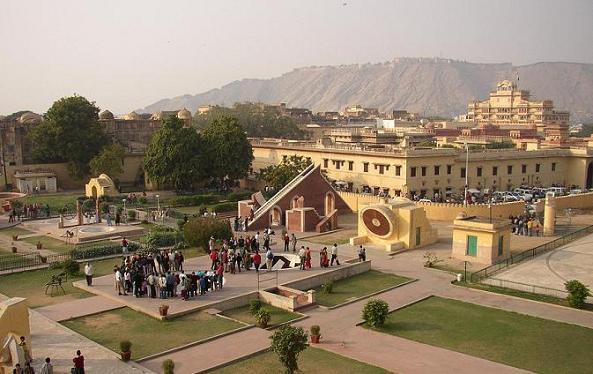
Jantar Mantar Translated into 'Instruments of Measuring the Harmony of the Heavens', Jantar Mantar was built by Sawai Jai Singh between 1728 and 1734. Jantar Mantar is a grand celebration of astronomical science and each instrument here serves a particular function and gives an accurate reading. Major Yantras or instruments that you can watch moving clockwise are: 1. Small 'Samrat' 2. 'Dhruva' 3. 'Narivalya' 4. The Observer's Seat 5. Small 'Kranti' 6. 'Raj' 7. 'Unnathamsa' 8. 'Disha' 9. 'Dakshina' 10. Large 'Samrat' 11. 'Rashivalayas' 12. 'Jai Prakash' 13. Small 'Ram' 14. Large 'Ram Yantra' 15. 'Diganta' 16. Large 'Kranti' Nahargarh Most of the fort is now in the ruins but it is a pleasant attraction in terms of stunning views you get from here of the countryside. There are few visitors here and solitude inside the ramparts of the fort makes the fort worthy of a good visit. The fort is lit beautifully in the night and dominates the skyline by the day. Central Museum Earlier known as Albert Hall, this building was built to welcome Prince of Welcome during his visit to India in 1853. The building is located in sprawling Ram Niwas Garden and houses precious collections of metalware, miniature portraits, and other pieces of art. JAIPUR - EXCURSIONS Amber Fort Amber is located around 11 km north of Jaipur and was ancient capital of Kachchwaha Rajputs. It was Sawai Jai Singh who changed the capital of this warring clan to Jaipur after an interrupted run for around 700 years. The site is one of the most popular in India during the tourist season and elephant rides from the base of the fort to the hilltop. There are excellent views from the hilltop of the countryside and Maota Lake below. You can also boat on the lake for fixed amount of money. Some of the better-known buildings inside the fort are Raj Mahal, Suraj Pol, Singh Pol, Shila Mata temple, Diwan-I-Aam, Ganesh Pol, Jai Mandir, Shish Mahal, Sukh Niwas, Sohag Mandir, and Palace of Man Singh I. Jaigarh Fort Jaigarh Fort or the Victory Fort is another fort palace of Jaipur located not far from the Nahargarh Fort. Main attraction inside the fort complex is the series of water reservoirs built to store and supply clean water to Jaipur City. Jaivan was the largest hand operated canon in the world and weighs 50 tones. The fort is almost intact as the enemies could never capture it and most of the parts are open for public viewing. Gaitor Situated just 8 km away from Jaipur, Gaitor has the marble and sandstone chhattris of the rulers of Jaipur. These chhattris were built by Jai Singh II and set in landscaped gardens. Sisodia Rani ka Bagh Sisodia Rani ka Bagh is located 8 km east of Jaipur on the Jaipur - Agra road. This garden palace was built for the second wife of Jai Singh and has attractive tiered gardens with mountains, watercourses, and pavilions with murals. |
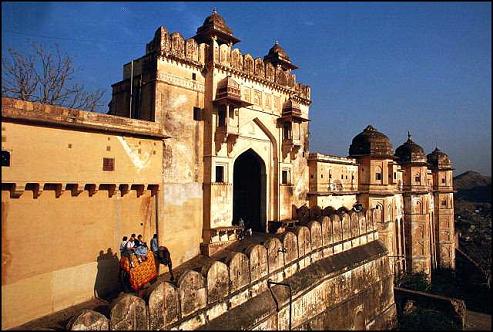 |
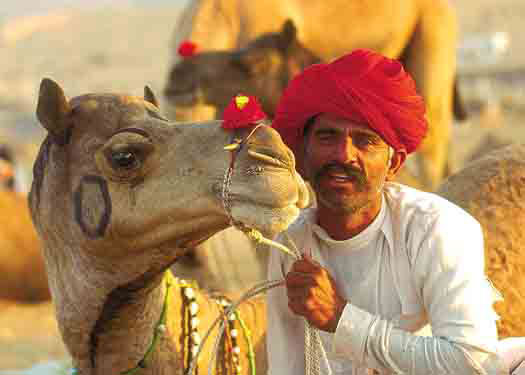 |
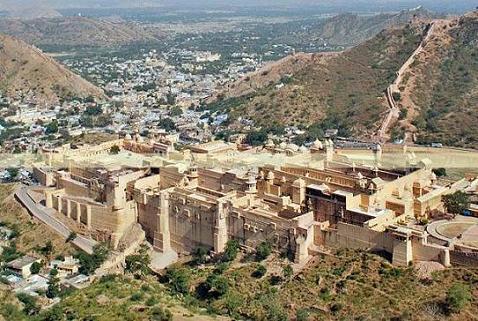 |
JAIPUR - TRANSPORTATION
By Air
Sanganer Airport at a distance of around 11 km from the city center is the main air gateway to Jaipur. There are direct flights to Delhi, Mumbai, Udaipur, Jodhpur, Aurangabad, and some other cities from Jaipur.
By Rail
From Delhi, there are many trains that connect Jaipur and other cities in Rajasthan; foremost among them is the Palace on Wheels. Other important trains include, Shatabdi Express and Pink City Express both from Delhi.
By Road
From Delhi, there is a direct and well-maintained road to Jaipur. City is connected to most of the tourist destinations in Rajasthan as well as Agra. Jaipur is part of the Golden Travel Circuit of India that includes Delhi, Agra, and Jaipur. Most of the tours are conducted either through the buses or trains.
Local Transport
Taxis and autos are the most convenient ways of moving inside the city as well as to reach some of the excursions located in the proximity. To move inside the city, you can also look for cycle rickshaws, which are easily available and much cheaper than other transportation modes.
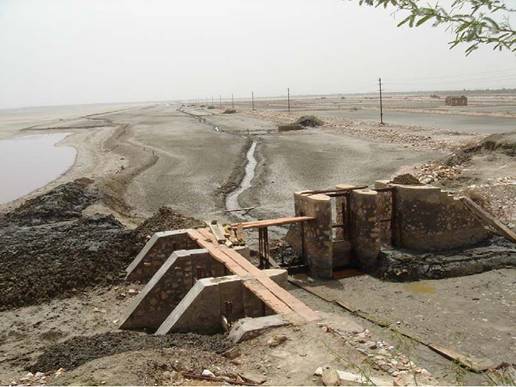
SAMBHAR - Famous for the country's largest inland salt lake, is an ancient city. It was the first capital of the Chauhan dynasty. Sakambhari, as it was founded near the temple of Goddess Sakambhari, famous for its holy Devyani tank, the palace and the nearby Naliasar: where the 3rd century onwards sculptures and terracottas were found in excavation. This place is situated on the Sambhar-Naraina Road.
VIRATNAGAR - 86 K.m. on the Shahpura-Alwar road, The site of ancient Viratnagar is of great antiquity. It contains the relics and structures of Mauryan, Mugal and Rajput periods.
RAMGARH LAKE -
(28 Kms) the huge artificial lake, a popular picnic spot. The
ruins of the old fort and the temple of Jamwa Mata indicate that
it was the seat of power of the Kachhawahas before they moved to
Amer.
SAMODE - (40 kms) a quaint village amidst the hills, the Samode palace set in fairy tale surrounding, has beautiful wall paintings & mirror works, now this is a heritage hotel.
BAGRU - (35 Kms.) the village on the Ajmer road, is known for its hand block printing, the characteristic prints are called as Bagru prints. The fort here is still in a good condition.
SANGANER - (16 Kms.) another centre of hand block printed textile and hand made paper. The town is entered through the ruins of two Tripolias (Triple Gateways) The town is an important centre for crafts industry and produces some of the finest hand printed textiles from units of block and screen printers. This textile is popular all over country and abroad.
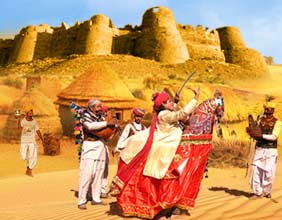 |
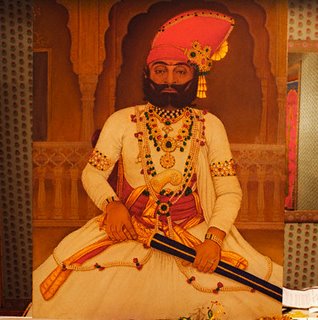 |
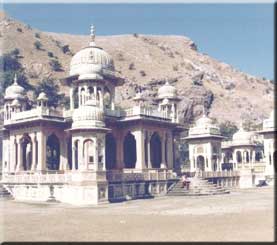 |